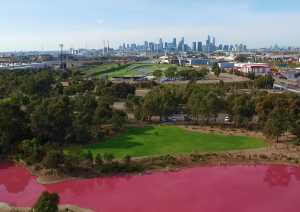The waters of a lake in Melbourne recently became pink as a result of an unusual environmental phenomenon. The lake is located in Westgate Park, just off the Yarra River and Port Phillip Bay in central Melbourne.
The lake’s cotton-candy-shade may look slightly ominous, but the effect is completely natural. It’s created by a combination of high salt level, hot temperatures, minimal rainfall and lots of sunlight.
These conditions cause a type of algae growing in the salt crust at the bottom of the lake to release a red pigment called beta carotene – a name you might recognize because it’s the same pigment found in fruits and veggies like apricots and carrots.

The striking phenomenon has local photographers tickled pink (we couldn’t resist) and is expected to last until rainfall increases and temperatures cool later this season. While the red pigment itself isn’t harmful to local birdlife (or potential swimmers), park authorities are recommending visitors skip taking a dip in the rose-coloured waters because the high salt levels are likely to make the experience unpleasant.
The Westgate Park lake’s proximity to urban Melbourne has made it especially popular with photographers, but it’s not the only body of water in Australia known to go bubblegum-coloured. Lake Tyrrell, Victoria’s largest salt lake; Lake Hillier in Esperance; and Hutt Lagoon (which also sometimes turns a purple-ish colour) are a few other spots where you can see this Instagrammable natural occurrence.
Learn more about Australia's pink lakes here.
